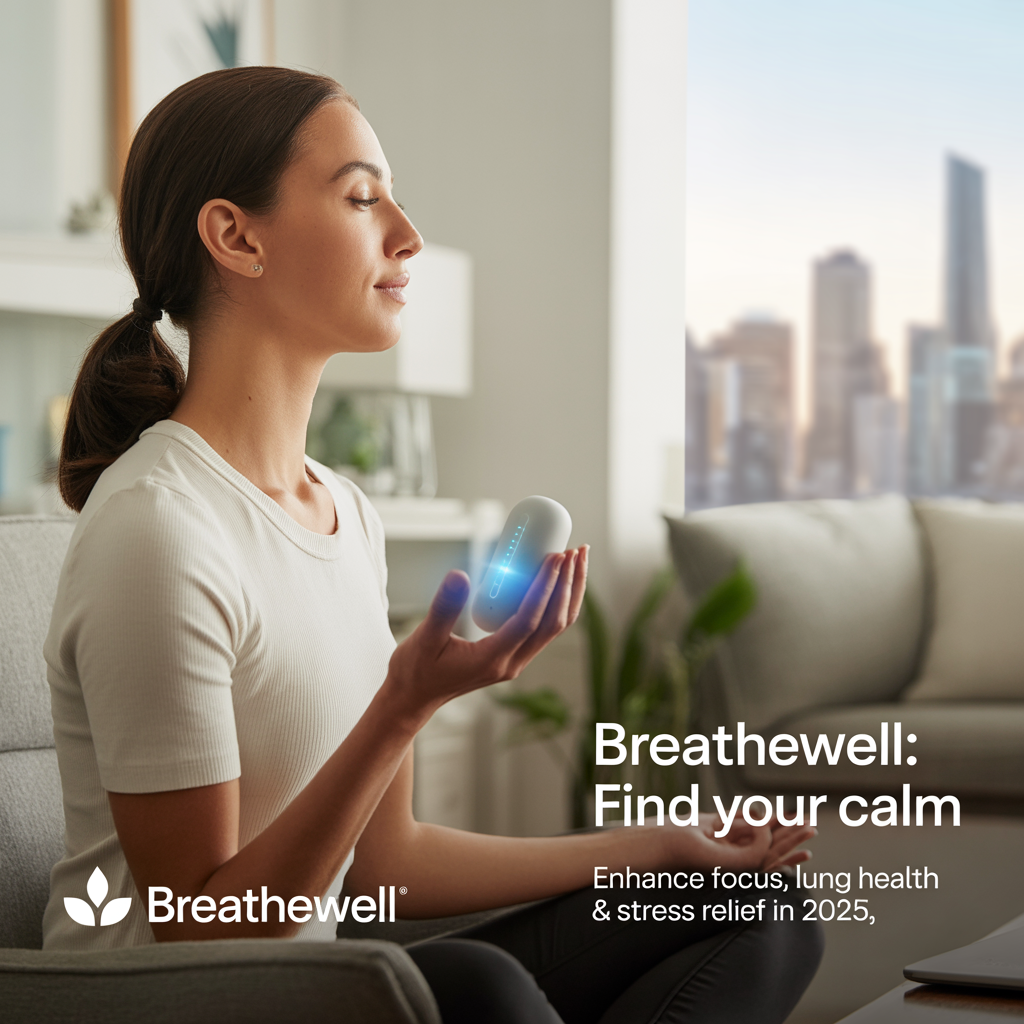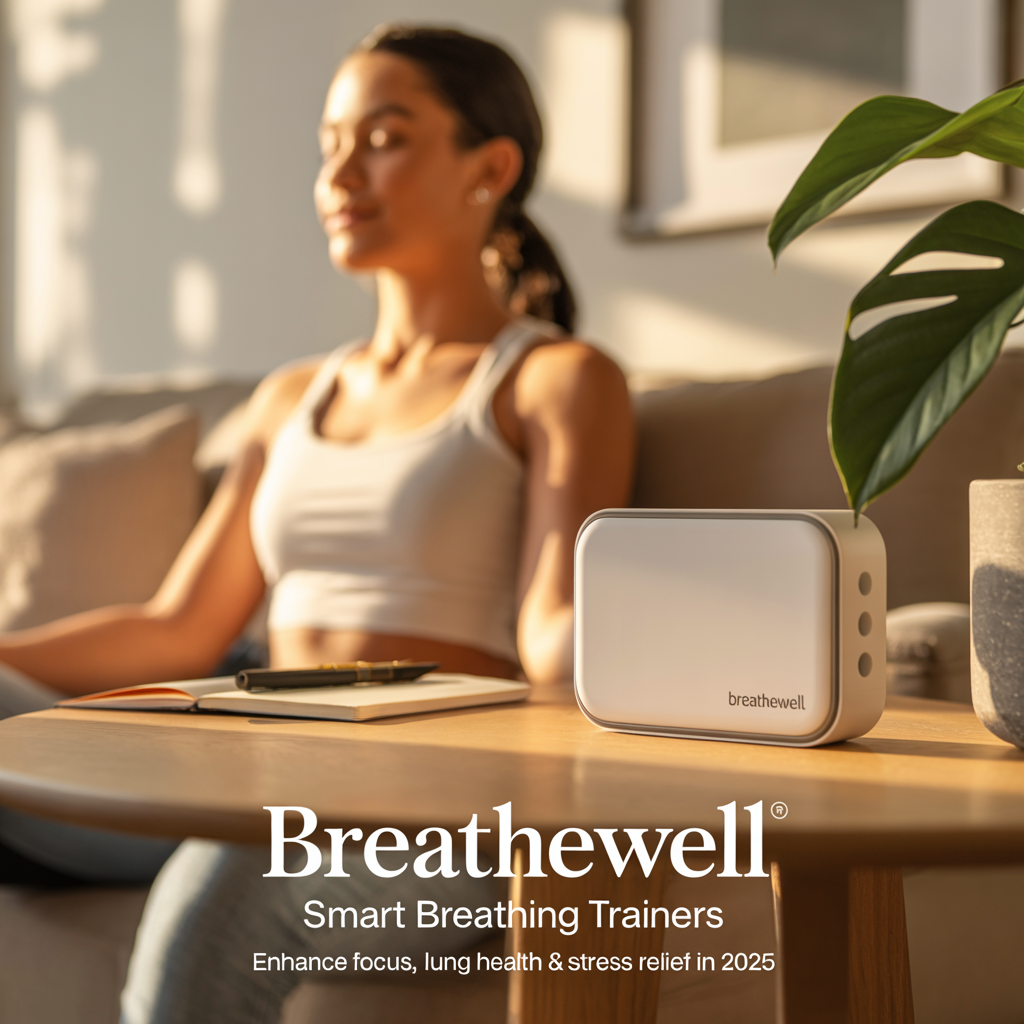
There was a time when I thought my breath was just… there. Automatic, nothing special. But after a series of sleepless nights before big presentations, a friend handed me a peculiar gadget: a smart breathing trainer. It beeped, buzzed, and—most importantly—taught me that breathing could be trained, much like a muscle. Fast forward to 2025, and these devices have evolved into sleek, data-driven companions for anyone looking to optimize focus, boost lung health, and chase off stress monsters. In this post, I’ll peel back the curtain on how smart breathing trainers use tech, sensors, and real-time feedback to turn each inhale into a power move. Whether you’re an aspiring biohacker, a marathoner, or simply seeking calmer days, the right breath can change your game. Let’s take a fresh breath and dive in!
Why Breathing Matters More Than Ever: The Science—With a Twist
Here’s something that might surprise you: most high-achievers I know are terrible breathers. I’m talking about shallow, chest-focused breathing that keeps them locked in a state of chronic stress. It’s epidemic, really—and it’s costing us more than we realize.
The science behind diaphragmatic breathing training reveals just how profound this simple act can be. When you breathe slowly and deeply, engaging that dome-shaped muscle beneath your lungs, you’re literally rewiring your nervous system. Research shows that this type of breathing enhances cognitive agility, resets stress responses, and optimizes brain function in ways that shallow breathing simply can’t match.
The Hidden Cost of Poor Breathing
Poor breathing habits create a cascade of problems that many people don’t connect to their breath. Sleep struggles? Often linked to inadequate oxygenation and elevated stress hormones. Anxiety spirals? Shallow breathing triggers the sympathetic nervous system, keeping you in fight-or-flight mode. Flagging performance at work or in the gym? Your cells aren’t getting the oxygen they need for peak mitochondrial function.
As Dr. Patricia Gerbarg puts it:
“Breathing is the remote control of the brain.”
This isn’t just poetic language—it’s backed by measurable physiological changes.
The Tech Twist: Making Progress Visible
What’s changed the game in 2025 is breathing technology for focus that brings real-time biofeedback to this ancient practice. Smart breathing trainers use sensors and algorithms to track key metrics like heart rate variability (HRV), oxygenation levels, and vagus nerve stimulation. Suddenly, the invisible becomes visible.
Studies indicate that users can see HRV improvements of up to 15% after just 8 weeks of consistent breath training. That’s not just a number—improved HRV correlates with better stress resilience, enhanced recovery, and sharper cognitive performance.
Beyond Athletes: Respiratory Muscle Training Goes Mainstream
Here’s an emerging trend that caught my attention: respiratory muscle training is no longer just for elite athletes. Office workers, executives, and anyone dealing with chronic stress are discovering that strengthening their breathing muscles can be as important as strengthening their core.
The technology now provides personalized coaching that adapts to your current lung capacity and breathing patterns. Some devices offer resistance training for your respiratory muscles, while others use gentle vibrations or visual cues to guide your breathing rhythm. The key is consistent practice with measurable feedback.
What makes this particularly compelling is how it addresses the root cause rather than just symptoms. Instead of reaching for another supplement or stress-relief gadget, you’re training a fundamental bodily function that influences everything from sleep quality to mental clarity.
The market for these devices is projected to grow at a 7.1% CAGR through 2033, reflecting growing awareness that proper breathing isn’t just nice-to-have—it’s essential for peak performance in our high-stress world.

Unexpected Perks: Smart Breathing Trainers Beyond the Basics
When I first started exploring smart breathing trainers, I expected basic lung health benefits. What I discovered instead was a whole ecosystem of unexpected advantages that extend far beyond simple respiratory improvement. These devices are quietly revolutionizing how we approach everything from athletic performance to professional presentations.
Athletic Performance Gets a Data-Driven Boost
VO2 max and lung strength upgrades aren’t just for Olympic athletes—daily users report notable stamina increases that surprised even seasoned fitness enthusiasts. Research shows that these top rated breathing trainers can improve lung capacity by up to 30% within weeks of consistent use. I’ve seen weekend warriors suddenly crushing their previous running times, not through intensive cardio training, but by optimizing their breathing patterns with devices like the Airofit Pro 2.0.
The PowerBreathe Plus has become particularly popular among breathing devices for athletes because it provides measurable resistance training for respiratory muscles. Users track their progress through connected apps, turning breath training into a gamified experience with concrete metrics.
Anxiety Management Becomes Scientific
Here’s where things get really interesting. Stress and anxiety management become data-driven—see your nervous system relax as you breathe. Modern biofeedback breathing devices like the Oxa Wearable don’t just guide your breathing; they show you real-time heart rate variability changes as your parasympathetic nervous system activates.
Over 60% of surveyed users report improved sleep quality after four weeks with a breathing trainer, according to data aggregated from manufacturer trials. The Moonbird Breathing Coach takes this further by providing tactile feedback—a gentle expansion and contraction that syncs with optimal breathing rhythms for breathwork for anxiety management.
“Smart breathing trainers are transforming how we approach both wellness and recovery,” says Anders Nielsen, CTO of Airofit.
Professional Voice Users Discover Hidden Reserves
Voice and performance professionals have new tricks: smart trainers help singers and speakers tap hidden breath reserves. Opera singers are using devices like the Betterair BreatheFlow to extend their vocal range and control. Public speakers report feeling more confident during presentations, knowing they have trained breath support backing their delivery.
The diversity is striking. Product diversity includes tactile, app-connected, and wearable designs—exploring personal fit is key. Some users prefer the discrete Oxa that clips onto clothing, while others gravitate toward handheld devices like the Moonbird for focused meditation sessions.
Unexpected Use Cases Keep Emerging
Imagine prepping for a big interview with a pocket-sized breath coach whispering feedback. That’s not hypothetical anymore. Professionals use these devices for pre-meeting calm, students employ them for test anxiety, and even new parents find breathing trainers helpful for managing stress during sleepless nights.
Devices like the Moonbird, Betterair BreatheFlow, and PowerBreathe Plus cater to different use-cases from meditation to COPD recovery. What started as respiratory therapy tools have evolved into comprehensive wellness devices that address multiple aspects of human performance and wellbeing simultaneously.

Making Tech Work for You: Tips, Cautions, and Real-World Stacking Hacks
Let me share what I’ve learned from testing multiple breathing trainer devices over the past year. The key isn’t finding the perfect device—it’s building a system that actually sticks.
Start Small, Win Big
Here’s my honest take: how to use breathing trainers effectively starts with just 5 minutes daily. I see too many people jump in with 30-minute sessions, burn out after a week, then let their $200 device collect dust. Research shows that app guidance supports adherence better than going solo—those little notifications and progress tracking features aren’t just gimmicks.
Most modern devices now feature adjustable resistance and mobile app breathing programs that adapt to your skill level. This personalization is becoming the new norm, and it’s game-changing for consistency. Start with the easiest setting. Build the habit first, optimize later.
The Real Geek Move: Device Stacking
Want to multiply your results? Pair your breathing trainer for athletes with other wearables like Whoop or Oura rings. I call this “the stack,” and it provides full-body insights that single devices miss. When your HRV data from your ring correlates with your breathing session metrics, you start seeing patterns that transform your training.
Studies indicate that stacking breath tech with other wellness tools multiplies benefits. My personal favorite combo? Breathing trainer + cold exposure + HRV monitoring. The data becomes incredibly rich.
Timing Is Everything
Use breath training strategically: pre-performance for focus, post-workout for recovery, or before bed for better sleep. But here’s the catch—avoid marathon sessions. Your respiratory muscles need recovery time too. I learned this the hard way during my first month.
‘Every breath offers a new opportunity, especially with today’s powerful tools.’ — Dr. Michael Gelb, sleep and airway specialist
Safety First, Always
Before diving in, consult your doctor if you have severe asthma, COPD, or cardiovascular concerns. These aren’t just legal disclaimers—they’re real considerations. Personalized breathing exercises should enhance your health, not compromise it.
Best practice tip: nose breathing equals greater oxygen efficiency. Most apps will guide you through this, but it’s worth emphasizing.
Beating the Boredom Factor
Don’t overlook this: switch devices or programs to keep things fresh. My first breathing trainer gathered dust until I mixed in cold exposure sessions. Now it’s part of a rotation that includes different apps, resistance levels, and even guided meditation breathing.
Price and accessibility remain chief obstacles for newcomers, especially as the market expands rapidly in Asia-Pacific regions. But even basic devices with app connectivity can provide significant benefits when used consistently.
The majority of today’s devices feature mobile app metrics that turn breathing into a trackable, improvable skill. That’s powerful stuff when you stick with it.

Wild Card: Imagining the Future—Will AI Breath Coaches Become Our Wellness BFFs?
Picture this: you’re settling into bed after a long day, and your smart breathing wearable automatically detects your elevated stress levels. Without you lifting a finger, it syncs with your smart home system, dimming the lights and starting a personalized breathing session designed specifically for sleep optimization. This isn’t science fiction—it’s where breathing trainer technology is heading in the very near future.
I’ve been following the trajectory of these devices, and honestly, the possibilities keep me up at night (in the best way). Research shows that devices are trending toward seamless AI integration, ecosystem syncing, and hyper-personalized coaching experiences. We’re talking about biofeedback breathing devices that don’t just track your breath—they anticipate your needs before you even realize them.
Could AI-driven breathing coaches nudge us into better habits without us even thinking about it? I believe we’re approaching a world where your breathing trainer becomes as essential as your smartphone, quietly working in the background to optimize your wellbeing. Imagine your device learning your stress patterns, recognizing when you’re about to have a tough meeting, and proactively guiding you through a quick coherence session.
Sometimes I ponder whether traditional personal trainers will become obsolete, or if they’ll evolve into AI avatars cheering us on for our next deep inhale. The truth is, both scenarios might coexist. While nothing replaces human connection, AI coaches could provide 24/7 support with real-time feedback that’s impossible for humans to deliver consistently.
“The next horizon isn’t just knowing your breath, it’s living in sync with it—everywhere.” — Dr. Leah Lagos, performance psychologist
Innovation watch reveals that biofeedback and smart home integrations are driving the next wave of breath tech. I envision breathing trainers that communicate with your fitness tracker, your meditation app, even your car’s climate control. When you’re stressed in traffic, your vehicle could automatically adjust the air quality and prompt a brief breathing exercise through your steering wheel’s haptic feedback.
Here’s a philosophical tangent that keeps circling back: Is “optimal breathing” a moving target, or will technology eventually reveal a perfect pattern for each person? Research and development are leading to ecosystem integrations with more data, more personalization, and more opportunity than ever before. Each breath could become a data point in your personal wellness algorithm.
The future of breathing trainer technology isn’t just about better sensors or sleeker designs—it’s about creating an invisible support system that helps us breathe better, live calmer, and perform at our peak without conscious effort. These smart breathing wearables might just become our most trusted wellness companions, understanding our needs better than we understand them ourselves.
As we move toward this integrated future, one thing becomes clear: the breath that once seemed so automatic is becoming the most intentional tool in our wellness arsenal.
TL;DR: Smart breathing trainers in 2025 empower users to monitor, train, and enhance their mind-body connection for better focus, faster recovery, stress relief, and deeper sleep—all with a few mindful breaths a day.


